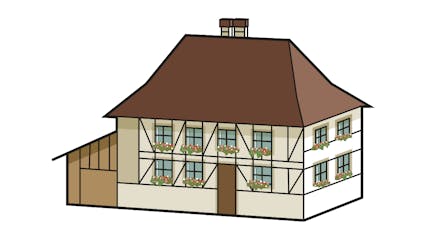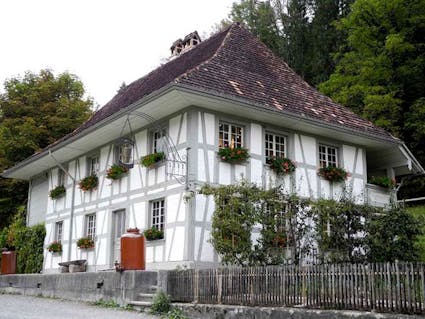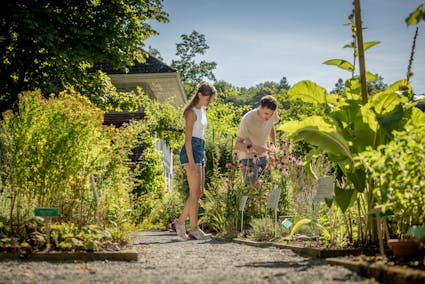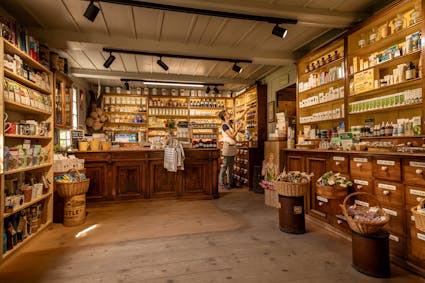381 – Craftsman's House from Herzogenbuchsee Berne, 1779
The Craftsman’s House, where the historic drugstore is now located, was built by the weaver Johann Jakob Baur.

House of contrasts
Timber walls sunburned dark and low-eaved thatched or shingled roofs characterise the farmhouses of the Bernese Midlands. They are down-to-earth, massive, hearty buildings. This craftsman’s house from Herzogenbuchsee is quite different: Only the floor plan resembles that of a smallholder’s house. The high-eaved tiled hip roof, the painted half-timber woodwork with white infills lend a measure of grace to the house. Smoke does not rise arbitrarily from the roof – an urban-looking double chimney conducts it formally away. It appears to be a bourgeois dwelling. What is it?

New beginning in a depression
In Upper Argovia linen weaving, after farming, had been the most important source of income since the 17th century. Weavers and small traders formed the middle class. Johann Jakob Baur belonged here. In 1777 he fi led for a permit to build this craftsman’s house. Since the textile industry was undergoing a crisis, Baur planned a few innovations.
Architecture of progress
Until then looms had been located on farms. Farming, cottage industry and weaving as auxiliary work went hand in hand. In 1778 the new house of the hosiery magnate Baur rendered this close-knit arrangement obsolete. Ateliers and living space are still under one roof but lie on opposing sides of a well-lit corridor. Large windows admit light into the workrooms. The house design excludes agricultural activity. The building breathes the spirit of early industrialisation. It is no accident that it stood on the new highway from Zurich to Berne. Hardwood floors and fancy tile stoves inside fulfill the promise of wealth and progress made on the outside.
Home remedies from the herb garden
At the Craftsmen’s House from Herzogenbuchsee BE and in the Stöckli (382) from Köniz, it’s all about naturopathic medicine and the history of the druggist's profession in Switzerland. The central feature is the herb garden in which many plants are grown, for use either in the production of natural fragrant essences and care products or as natural healing remedies, as has been the case since time immemorial.
The display on the first floor of the Drugstore (in the Craftsman’s House from Herzogenbuchsee) relates the history of naturopathy and its significance for the drugstore. Like the herbalist priest Künzle and Dr. Alfred Vogel, the druggists always possessed thorough knowledge of drugs, herbs and botanical medicine.

Home remedies produced in the museum
The main attraction in this world of herbs and tinctures is the Historical Drugstore from Herzogenbuchsee (381). Here you can buy some of the tried and tested products produced in traditional fashion in the museum. These products include, for example, roll-on ribwort which helps against insect bites, or the liquid chervil preparation which in folk medicine was known as a remedy for blood disorders. The plants grow directly behind the drugstore. Other favourites are products such as marigold ointment, tincture of arnica or syrup of thyme. Knowledge of the healing properties of certain plants was widespread in past centuries. Farming families either produced various remedies themselves or delivered the herbs to the drugstore. “We want to show how simple and natural the production of these remedies was”, says drugist Beni Haslebacher.
Other products are also available in the little shop. Haslebacher calls them the “What-you-call-its“ which are practically unobtainable nowadays, such as the twisted barley malt sugar sticks or Wybert tablets. The furnishings and fittings in the Ballenberg drugstore come from La Chaux-de-Fonds. The drugstore is, in fact, the original shop area of the Droguerie Robert Tissot, which was in operation until 1955.

Ballenberg
Swiss Open-Air Museum
Museumsstrasse 100
CH-3858 Hofstetten bei Brienz
Opening hours
11 April to 27 October 2024
10 am to 5 pm daily